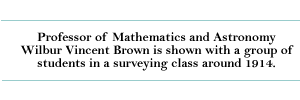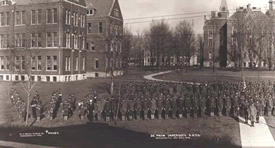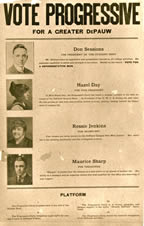
|
Pages: << Back 4 5 6 7 8 9 10 11 12 13 While
black and gold had recently been adopted as the official school
colors, there was yet no generally accepted name for DePauw's varsity
athletic teams. "Fighting Parsons" was occasionally applied
to the football eleven, but the usual
term for the university's representatives in intercollegiate sports
competition was simply "Old Gold." The present usage dates
from the spring semester of 1917-18, when the "D" Association
sponsored a contest to pick an appropriate epithet, one that would
reflect varsity fighting spirit as well as the school colors. "Tigers"
won out easily over such suggestions as "Yellowjackets,"
"Wasps," and "Yellow Demons," and quickly attained
the popular favor still evident today.
By
1918 President Grose had been able to make significant additions
to the teaching faculty. Among those who were to have relatively
long careers at DePauw were Lisgar R. Eckardt, another Boston Personalist,
in philosophy; Raymond W. Pence, a specialist in writing, along
with Edna C. Hayes in English; William W. Sweet, who replaced the
popular Andrew Stephenson as head of the history department; William
Wallace Carson and Katherine Alvord,
also in history; Edwin B. Nichols in Romance languages; Rufus Town
Stephenson in Greek language and literature; and Walter N. Hess
in biology. Classicist Stephenson also introduced courses in art
history in a new department by that name. Before
the close of the academic year 62 men had left campus for military
service and 42 for farm work. Classes opened in the fall with 140
fewer students enrolled than the previous year, and men continued
to withdraw during the next several months. Students and faculty
started war gardens, subscribed to relief funds, purchased Liberty
Bonds, and sent Christmas boxes to men in the service. In August
1918 DePauw contracted to take part in the belatedly organized Students'
Army Training Corps and sent 17 students and two faculty members
to a summer training program at Camp Sheridan. On October 1, 500
men were inducted into the S.A.T.C. in a ceremony near the Boulder. |
Depauw University e-history | E-mail comments to: archives@depauw.edu





